What I Saw – by Jackie Philpott

Us Versus Them?
During these fractious political days there is a real US vs. THEM attitude almost everywhere. In this story I consider the differences that divide Americans. You know what I’m writing about: There are people willing to tolerate the heat in the Delta and others who just won’t. I try to capture that division between us in this story.
The Voice Of Reason
There are phenomena in the Delta known as The Voices of Reason. They are experienced when people visit from Outside Over There. Since only three guests had visited Dura Mater and me in the Delta in 2017, I had very limited data with which to evaluate this trend, but that was my first trip so I decided to wait a couple of years to see if additional experience confirmed the need for further study.
The Voice of Reason came to collect me a few days after I arrived in Owl Harbor in 2017. He came in the middle of the day, when it was already wicked hot. I encouraged him to arrive early, when it is cool and lovely, but The Voice of Reason thinks like a city person, so he waited a bit to avoid the traffic. Well, of course no one drives from Oakland to the Delta in the middle of the week. Anybody can see that from the traffic on the other side of the freeway. But there is no arguing with The Voice of Reason, so I trudged up to the levee road in the blazing heat when he arrived at 10:30 a.m.
He rolled down the window of the air conditioned car and blinked. “It’s hot!” Yes it was hot. It’s hot every day here, but the Really Hot would arrive later. He rolled the window back up and smiled at me through the glass.
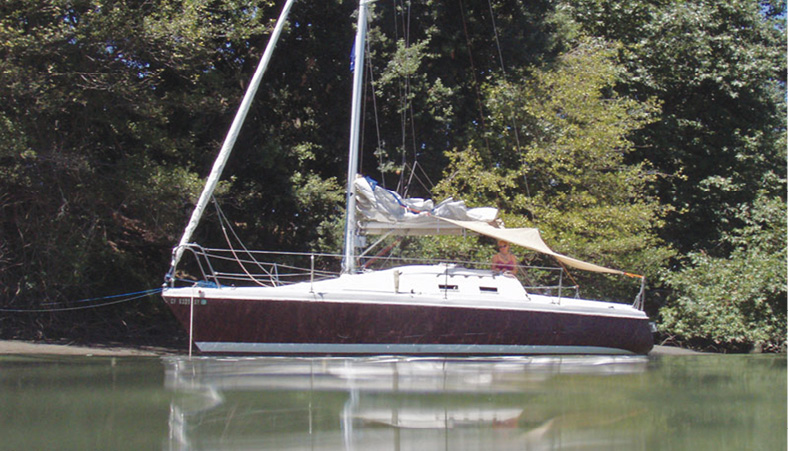
“Lunch?” I mouthed.
“Sure. Get in.” He replied.
“Let’s sail. It’s cool on the water. There’s a breeze out there. It will only take half an hour.”
“But we have a car,” said the Voice of Reason.
“But we have a boat,” I insisted. “I don’t know why we should drive a car when we have a perfectly good sailboat.”
“Because it’s air conditioned in here.”
The Voice of Reason waited me out. I could feel the heat melting my flip flops, so I sighed and got in. We drove to Korth’s Marina, had a nice lunch at the diner there, then drove back to J Dock.
“Come have a cup of coffee on the boat before we go back. The cockpit is shaded,” I lied.
We walked down the dock to Dura Mater, I got my beach umbrella out and stuck it in the winch holder for him. When we sat real close there was shade for both of us, and there was a nice little breeze. There is almost always a nice breeze in the Delta, something Voices of Reason don’t realize.
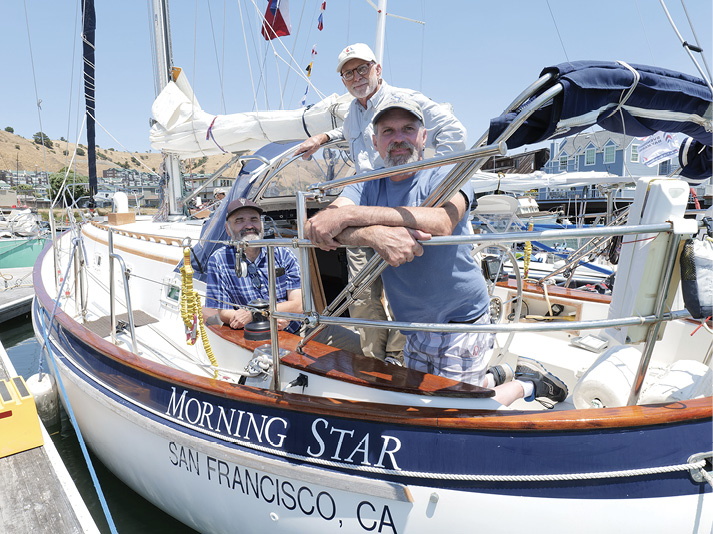
He pointed to Stink Eye’s perfectly situated triangular tarp: “Why don’t you have one of those? Or one of those?” He eyed a ski boat motoring by us. It had a bright red bimini that matched its gelcoat. The bimini provided shade to everybody sitting on its white leather seats and all their margarita glasses, too.
I told him about my conversation with the nice man at Pirates Lair diner a week earlier. The man told me that he had just paid $1,000 for a bimini for his small motor boat. “It was worth every penny,” he told me proudly. And I believe him. But a bimini is not worth $1,000 to me because I already have a beach umbrella.
After we drank our coffee it was time to go back to Oakland.
“Well, this is a nice place here,” The Voice of Reason admitted. “Maybe next time I visit we’ll go for a sail.”
That never happened. Those of you who have a sailboat and reluctant crew have experienced this phenomena. To this day I meet up with people who have never even been to the Delta. They tell me: “The water in the Delta is too shallow for a sailboat.” “The sloughs are too narrow for sailboats.” “The heat is too hot.” “The water is too muddy for swimming.”
My response to all that baloney? The water is plenty deep enough. The rivers are where you want to sail in the Delta, the sloughs are where you meander. When it’s hot in the Delta you can jump into the cool (not cold) water. The water’s not muddy at all, it’s just not a swimming pool. That’s my opinion and I’m sticking to it.
Pacific Cup Village At Richmond Yacht Club
The Pacific Cup is billed as The Fun Race to Hawaii. On the day before the start of the 2024 Pacific Cup I drove over to Richmond Yacht Club, which was the staging area for this year’s race. I chatted with sailors who were scheduled to leave the next morning for Kaneohe Bay. There had been a big party the night before where 250 people paid $60/each for a buffet and to drink at RYC’s bar.
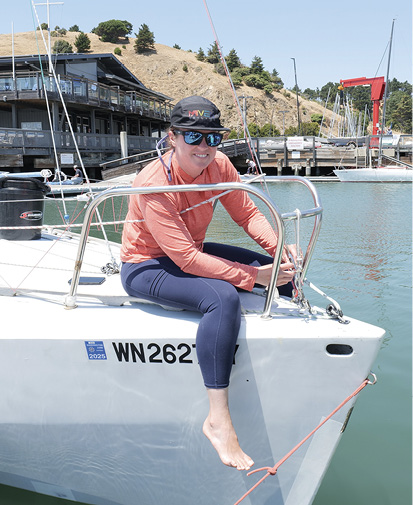
Needless to say, people seemed a bit subdued on this Sunday. Their boats were either ready to go, they were still preparing for take-off or they were home napping. Regardless, I walked around and chatted with some of my long-time favorites and some new-to-me favorites.
Greg Nelsen And Daniel Alvarez S/V Outsider
Outsider is always competitive in San Francisco Bay and ocean races. I asked Greg Nelsen what he thought about the conditions for the first two days of the race. The forecast called for very little wind the first two days of the race, during which time the boats scheduled to start the next day would be floating around on the water for a long time once they exited the Golden Gate. What was his strategy?
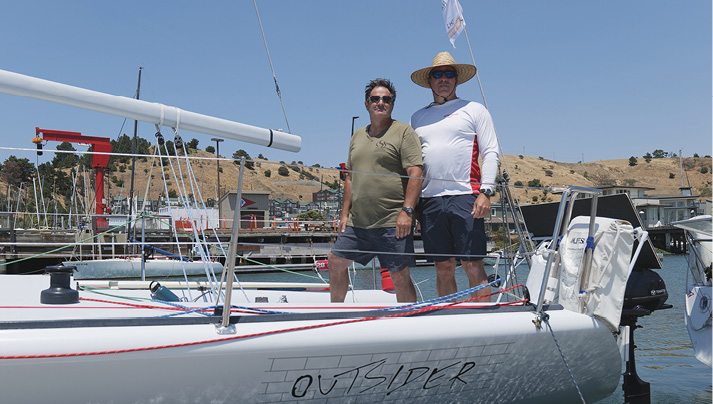
Greg said: “Uuggghh! Try to get off the coast! It’s gonna be bad for the first day and a half but it is what it is and we’re all gonna suffer together. After that it looks like it will fill in nice. Late Tuesday? We don’t have a 40# watermaker ‘cuz it weighs too much. We had plenty of water and then we bought more. We already had more than the minimum.”
Outsider is coming back from the Pac Cup on a trailer. Greg had just dropped off the trailer on Friday. Optimally, The Pacific Cup negotiates a group price with a shipping company. Racers who don’t want to sail their boats back across the Pacific after the race pay to have them shipped back by container ship. They deliver their boat trailers to Svendsen’s Bay Marine in Alameda before the race where they are loaded onto a freighter. It takes approximately six days each way for the freighter to get to Hawaii. After the race, the boats are loaded onto their trailer in Hawaii, then onto the freighter and shipped home. Outsider is a 31-foot Azzura raceboat, only 2000# with a ten-foot beam and a 7-foot draft. The cost of freight for Outsider is $10,800. I overheard people talking about the costs during COVID and how everything has become less expensive. This is an example of the word RELATIVITY. Everybody knows that ocean sailboat racing is expensive.
The whole time Greg talked to me he continued filling in and sanding microscopic pitting on his carbon fiber rudder. In the sunlight I couldn’t even see it, but Greg is a professional composite perfectionist. If he said there was pitting on his rudder then I believe there was pitting on his rudder.
On Friday afternoon I had photographed Buzz Blackett’s Antrim 27 sailboat S/V ‘IO as he lowered her onto the water with the club hoist. On this day I listened as Karl Robrock, ‘IO’s navigator, queried Greg regarding means of communicating via email offshore. Karl said to Greg, “If it’s really boring out there we might crack jokes with each other. Sort of like having a single sideband radio without having a single sideband radio.”
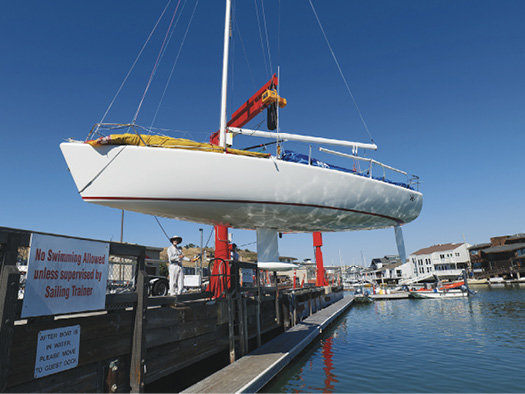
I asked, “Do you anticipate being bored on Buzz’s boat?”
And Karl, a Moore 24 sailor said, “No. It’s just that in the medium air stuff, on Buzz’s boat there are a million possibilities. On the Moore there’s just a kite. Maybe two kites. So you’re just flying the kite. If it gets really hairy you use the other kite. There’s a simplicity to that. I honestly don’t know what to expect in this race.”
I don’t pretend to be a race analyst, but as of the deadline for this column that little carbon fiber boat was certainly keeping up with the Joneses offshore.
The predicted winds and conditions arrived Monday morning, and for the first 24 hours most boats hadn’t yet reached the Farallon Islands, a mere 26 miles offshore.
Arthur Hesford And S/V Fiasco From The Royal Victoria Yacht Club
After talking with Greg and Daniel I walked over to E Dock before I remembered that my boat wasn’t there. I was just on automatic pilot: Kind of like following the smell of a cherry pie when you’re hungry. Well, it was a fine thing to do because there, at the end of the ramp I found this nice little Olson 30, the S/V Fiasco. Arthur Hesford, known as AJ, is the skipper and owner of Fiasco.
Aubrey Stuart will be the navigator and Serjei Moukminov will serve as crew. Serjei raced on the Windward 30 S/V Pitoraq in the 2019 Race to Alaska, so methinks he’s more than mere crew, but there he was crawling around in the stern locker getting the anchors sorted out. Pitoraq finished a very credible 12 out of a field of 35 in the R2AK, so I suspect AJ is probably counting on him to do more than just act as rail meat.
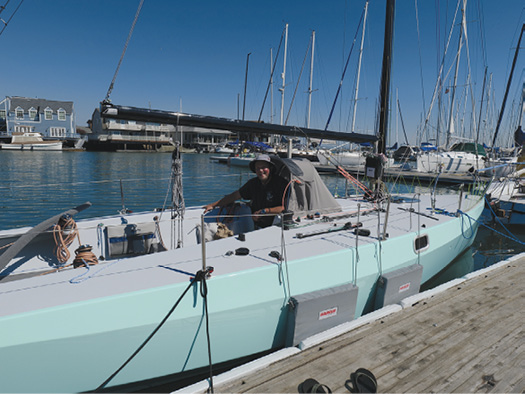
I had a terrific conversation with the very amiable AJ, who hails from the Royal Victoria Yacht Club in British Columbia. I asked him to tell me about his sail plan and whether he had trailered his boat down from British Columbia and he told me this story, which is a sailor’s tale, told well. He apparently had a wild ride down the coast but lived to tell me about it. He said, “About our sails: We have a #1, #2, #3, #4 and a storm jib, a windseeker, three symmetric spinnakers and one asymmetric spinnaker. No, two #2s! We had another #3 but it was an old one and it blew apart on our way here. We sailed here. Regarding our trip down? Well, Washington was very pleasant: A good sail. Oregon was quite nasty and California was surprisingly gentle.
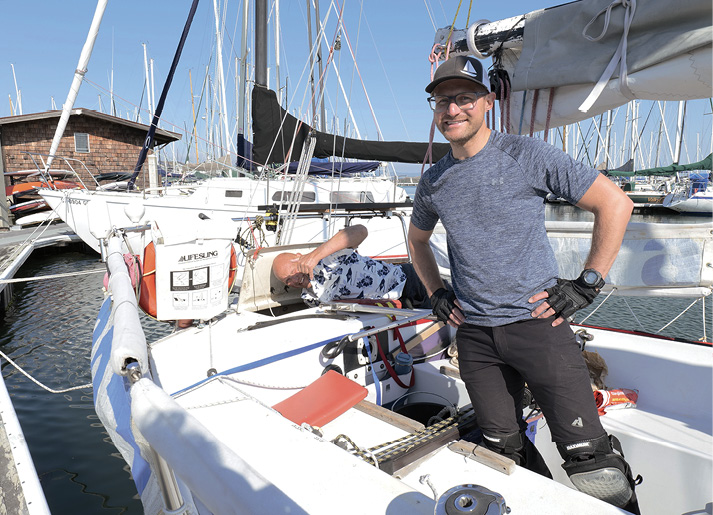
We left Victoria on the 9th of June and went over to Port Angeles and then we were at Cape Flattery by the second of July. I was happy that Cape Mendocino was not violent. It was kind of misty and we were motoring.”
I asked about his previous experience ocean sailing.
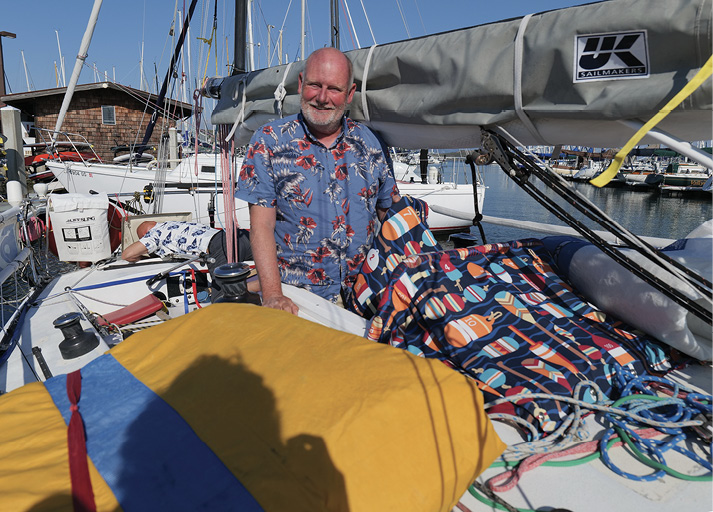
“In 2012 I sailed from Ontario, Canada down the east coast to Panama, then up to Baja California on a big fat ketch – vastly different from this boat. Extremely comfortable. It ended up on a reef in Hawaii.” Disconcertingly, he laughs at this fact. “Oh, and it was my boat.”
Although AJ has raced for ten years on Fiasco, this race will be his first across an ocean. The strategy aboard S/V Fiasco is “to not get nauseous, get to the start and get gone.” He knows boats and has had time to walk around the docks here at Richmond, look at the other boats, talk with the other sailing teams. So I knew that AJ was being tongue in cheek when he told me his ambitions for this race:
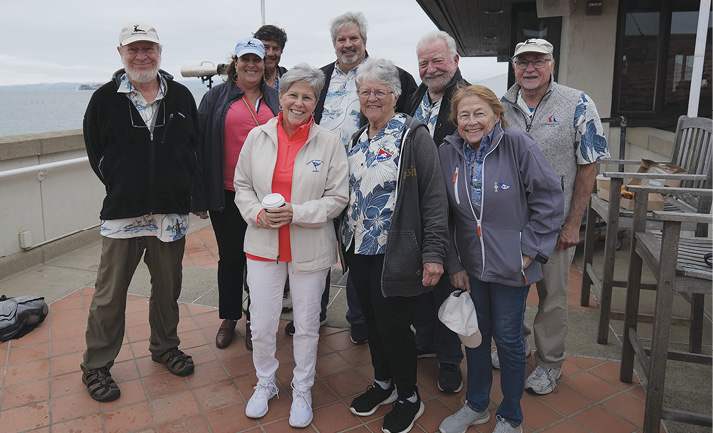
“We expect to have a wheelbarrow of trophies. Yes. We expect to win our division, the overall team award, Corinthian award and we will be first over the line. The smelliest, we’ve already got that one.
What I have really liked so far about this race was coming to Richmond Yacht Club. Danny, your Harbor Master, has been very welcoming. What’s nice about being here is that people come by to chat. They’re very respectful, too. And on Wednesday I went over and chatted with the race committee. Jim Quanci came by. He was very accommodating, very helpful.”
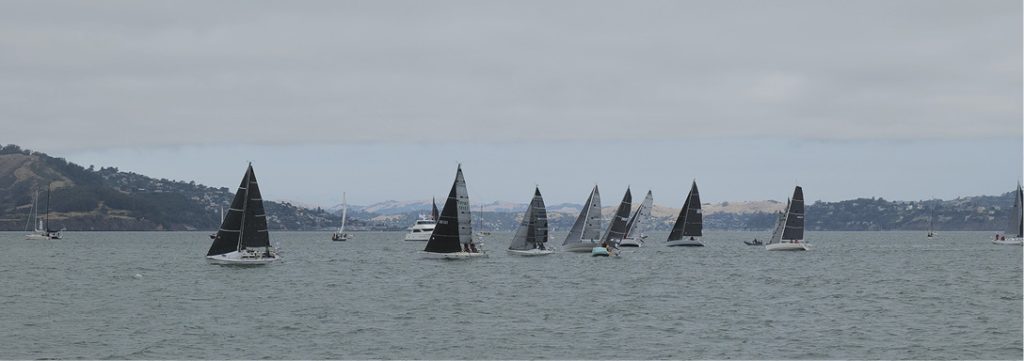
I took photos of AJ and the dodger he made himself. It’s a very short dodger but he says it does the trick, so I’ll take his word for it. As of this writing, Fiasco, a small fast boat in a serious race, is doing very well keeping up with the fleets. Lots of sailors in this year’s Pacific Cup have already sailed to Hawaii multiple times, so that is saying something for it. In a race that encourages recidivism, Olson 30 sailboats have historically done well sailing from here to there.
I wished my new Canadian friends well, then left them all behind and walked up to the clubhouse to see what was on offer for dinner. A.J. Hesford is a member of the Royal Victoria Yacht Club. I pondered how it might feel to be a member of a royal club. It sounds swell. From now on maybe I’ll tell people that I am a member of the Royal Richmond Yacht Club. Would you believe me if I told you?

Robert D’Arcy And The Schooner Martha
AJ had mentioned races up in the Pacific Northwest, so I googled some of them: The Swiftsure, the Van Isle and the Southern Straits. I’m sure those races are a lot of fun and certainly it is very beautiful sailing up there. While I was perusing the races hosted by the Royal Victoria Yacht Club, I noticed the name of Robert D’Arcy sailing the famous wooden schooner Martha, hailing from Port Townsend.
Martha was built in 1907-1908 at the W.F. Stone Boat Yard in San Francisco. In March of this year she participated in the CRISR (Captain Raynaud International Schooner Race). This is how the race course is described on its website: “Somewhere in and around the San Juan Islands of Washington State!” How’s that for ambiguity?
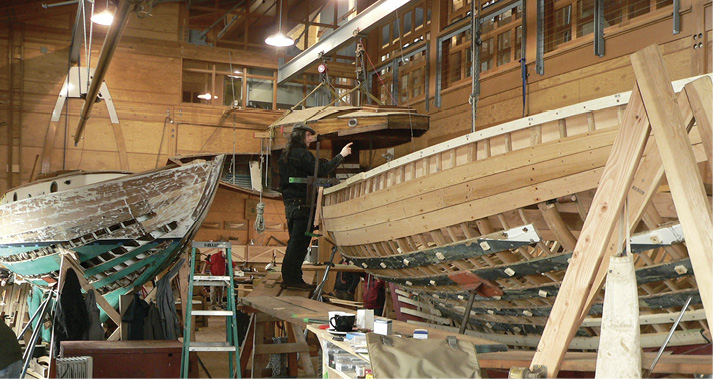
The sailing culture is closely knit and the same names come up again and again. Boat names. People names. In March of 2018 I was in Port Townsend delivering an autopilot for that year’s Race to Alaska. It’s cold in Port Townsend in March, by the way, so wear your woolies if you go early in the year.
While I was there, I wandered over to the Northwest Maritime Center and introduced myself to Robert D’Arcy. He is very knowledgeable. I asked him about himself and his relationship with the restored wooden Schooner S/V Martha and this is what he had to say:
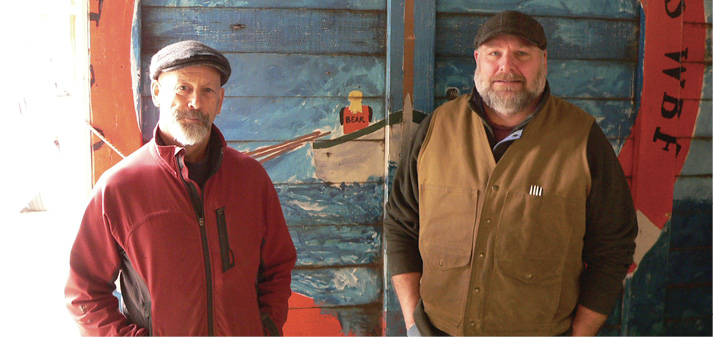
“I grew up on the East Coast as the fourth generation of a boat building family. My great grandfather came from Scotland as a shipwright, and owned a business in Providence, Rhode Island. His son, my grandfather, was sent back to Scotland as an apprentice when he was sixteen and my grandfather taught my father and my father taught me. In today’s modern world it’s considered quaint to learn that way, kind of old fashioned, but I think there’s logic and science to it, too.
Before I left New England, I started a small company doing Victorian and Colonial remodeling. Because I was a boat builder I knew about radiuses and how to build complex molding. Things like that were not difficult for me. So I carved out a nice little business, lucrative in New England and then in the Bay Area. I was a subcontractor and I hired out to various firms looking for high-end material.
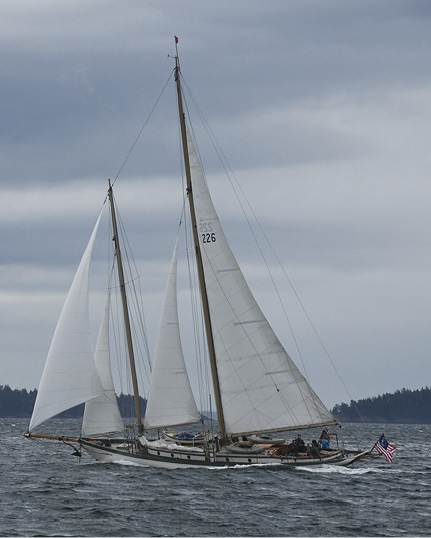
That’s what brought me up here. I took on a project to design and build a spiral staircase in a home up here. I liked it so much I stayed.
Then some people approached me and said, “You’ve got the skills. Would you want to take Martha over as a project and see if [you/we] can save her? I wasn’t interested at first, only because I understood that it would be a massive project. She was not derelict but she was very soft. It was obvious by getting onboard that she was extremely wet, and that there were a lot of problems associated with that. It was not too hard to figure out what she was going to need.
So, I read as much as I could find on her and recognized that she was an important American yacht. We decided that she should be on the register of historic vessels and that she deserved to be saved.
Together with Tim Maer, Joanne O’Conner, William and Ursula Paine, we created a foundation based upon a single ship trust. The Schooner Martha Foundation concept was born. We applied for 501(c)(3) status, with a mission to use her for sail training, to preserve her, curate her history, maintain the vessel and that’s what we’ve done.”
Racing The Schooner Martha
“Here in the Pacific Northwest, we have the venue for when a bunch of classic wooden boats show up to race against each other. We also race two premier events in the Northwest that are full on PHRF modern boats: The Round the County and Swiftsure. I think it was 2009 we won the Swiftsure Race on Martha, our division and overall. They couldn’t believe it! It was insane! We had great wind and we sailed well. We made some good decisions and we sailed well. Some sailors we had beaten got up in arms and complained about a lot of different things. There was a big thread in Sailing Anarchy about it. Then other sailors wrote in and pushed back, writing: ‘Oh, c’mon! You don’t care about their safety, all’s you care about is that you lost the race. They kicked your ass and that’s why you’re upset.’
“It went around and around and then in 2010 we didn’t do well. It was very light and fickle and people said, ‘Ah! You see! It was a one trick pony!’ Then in 2011 we took division and overall again. We’ve taken overall twice, we’ve taken our division three or four times.”
J: How many crew did you have when you were doing all this?
R: Twelve or thirteen. It was a kick in the pants! I remember one particular time, these guys and gals, they’re all on modern boats. And Martha is such an archaic thing! We raced against TP52s. You name it – we’re racing ‘em! Those boats can plane, we can’t, and if they get the right groove going where they can plane around the islands, they’re gone.
We can foot as fast as they can to weather, but they can point higher. But if we get a race that’s a little freer and we don’t have to beat and we have some pressure? Well, we’ve got waterline. We’ve got power. So there have been times when we’ve taken off in squally, winter conditions with a 35-knot squall and when the squall passes and we’re all becalmed waiting for the next windline? We’re parked next to the TP-52!
What we’ve learned is that they don’t get that sweet spot that often or for long enough. They just don’t. In a PHRF event we’re not match racing a TP-52, they’ll walk away from us and laugh all the way to the bank with it, you know? But for us, sometimes we get favorable conditions.
The same thing has happened at Swiftsure. It might have been 2013, I can’t remember now, we did the Swiftsure inshore class. It was 8-10 [knots] and it was going to be a weather leg and a downwind leg. We took overall. People say, “What? Because of the ratings?” We were third behind two Melges race boats. People said, “Oh my God! We can’t believe it!” It was because Martha hit a sweet spot! Neptune just took care of her! It’s amazing how that works. We’ve had a lot of fun racing up here in a mixed fleet, not just against the other classic wooden boats.
Racing Conditions In The Pacific Northwest Vs. The San Francisco Bay
In the San Francisco Bay you have strong currents, but they’re always in one direction or the other. Here the currents create very mixed conditions. Throughout the region up here there are a lot of back eddies. A lot of dynamics to the system depending on where you are. We race all over in uniquely different conditions, whereas in the Bay Area you race in only the one Bay, you know what I mean?
Here you have the Pacific Ocean trying to fill this place up. Think about how huge this region is. If you go from right here straight to Juan de Fuca, the Pacific pours in and takes a right-hand turn and goes all the way to Olympia. That’s a huge geography! It also turns left and goes through the islands all the way up into Desolation Sound! That water flows in right through the Strait to Juan de Fuca.
So, whenever you’ve got a back up of pressure trying to get through an opening and it’s having trouble getting through, quite often back eddies will develop on the edges. The main thrust of the current is in the middle, but you have back eddies on the edge.
Couple that with a strange bottom topography in which you might have 400 or 500 feet of depth, and then there’s a sea mouth and then it’s only 60 feet deep. The Straits and various places through here are like that all over. That causes upwellings and back eddy situations that you need to learn how to negotiate when you sail. Except it’s magnified here.
Local Politics:
Same As It Ever Was… Same As It Ever Was…
I’m on the board of the PTMTA, the Port Townsend Marine Trade Association. We’re putting our shoulders against the wheel to try to stop this idea that constantly developing into the new thing is the best thing. We’re trying to limit that kind of growth. This is way more important. It’s more than jobs for people. It’s jobs that people can live with, that can help you buy a home. If we redevelop, people are cleaning pools. You don’t make a living wage cleaning pools. You don’t make a living wage as a barista. You can’t compete. As people move into this market and the housing prices go up, local people can’t live here anymore. We’ve watched this happen everywhere. So, when are we going to do something about it?
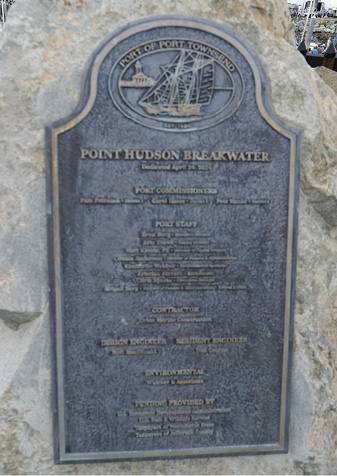
I believe the Port may have been going in the wrong direction when they decided they wanted to start redeveloping and getting heavy industry in or God knows what. Some people support the idea of urban renewal and redevelopment. Well, some of that is accurate and some of it is needed, but some of it is ridiculous. Growth for growth’s sake is not the answer. What happens with that is that a few people make a lot of money and the rest of the people have to work in… hotels, service industries. We already have a functioning, vibrant marine trades organization and workforce in town. What we need to do as a community is to tune it up and get it running clean and smooth, not throw out the window what makes this town unique.
The Northwest Maritime Center has made the city a proposal: The Center said, “Let the Maritime Center take on a long-term lease [of the Point Hudson Marina]. We’ll lease it and keep it as consistent with tradition as possible and that’ll take the financial pressure off the Port. It’s a really good plan and I’m hopeful. We’re at the end of the runaway here.”
When I was in Port Townsend earlier this summer, I stood on the brand new breakwater from which I photographed the boats starting the Race to Alaska. Somehow the people of Port Townsend persuaded the Federal Government to pay for a breakwater, which was christened in March of this year. I don’t know how that happened, but some people were obviously persuasive, and I suspect Robert was involved in the effort. Who can doubt a man who can compete with a Melges sailboat – a little plastic boat which weighs less than 2000 pounds – with a classic wooden schooner?
Thank you to the Schooner Martha Foundation for the photograph of Martha.
Until next month, thank you for reading. Email me at jackie@yachtsmanmagazine.com and let me know if you have anything you would like to share. Enjoy your time on the water and let’s all be careful out there.



